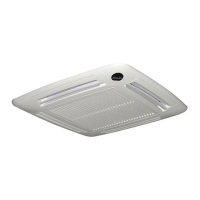7
IFCLTY 1112 - 4528511_04
- Cooling operation: the remote control
can be used to set the cooling mode
and the room temperature required
(setting). If the fan speed is set in
automatic mode, the control board
selects the fan speed and decides
the water valve opening on the basis
of the difference between the room
temperature set by the user (setting)
and the temperature measured by the
ambient probe. In the case of 4-pipe
systems, in cooling mode the control
board will pilot the cooling solenoid
valve while the heating solenoid valve
is closed.
- Heating operation:the remote control
can be used to set the heating mode
and the room temperature required
(setting). If the fan speed is set in
automatic mode, the control board
selects the fan speed and decides
the water valve opening on the basis
of the difference between the room
temperature set by the user (setting)
and the temperature measured by the
ambient probe. In the case of 2-pipe
systems, in heating mode the control
board will pilot the standard solenoid
valve. In the case of 4-pipe systems,
in heating mode the control board
will pilot the hot water solenoid valve
(accessory) while the cooling solenoid
valve is closed.
- AUTO (Automatic) operation: by
activating "AUTO" mode on the
remote control, the room temperature
is decided by the control board,
which will also select the fan speed
(operating in Automatic mode). The
thermostat reads the SA ambient
probe (continuously, even in heating
operation, despite the thermostat
being enabled) and decide whether
to operate in heating, cooling or
dehumidifi cation mode. It is possible
to correct the fixed operation setting
by ±5°C, using the remote control. In
automatic mode, the unit re-selects the
function after each start from standby.
- Heating operation with electric heater:
if the unit is fitted with an electric
heater for heating operation, then the
only fan speeds allowed are maximum
(V3) and average (V2); minimum
speed (V1) will only be automatically
activated in the post-heating phase.
The dip switches are used to determine
- during installation - whether the
electric heater is a supplementary or
replacement one.
Heating operation with supplementary
electric heater: the heater is activated
at the same time as the heating water
valve, to increase the efficiency of
the unit. Alternatively, if the water
temperature is insufficient, the heater is
activated to make up for the low output
provided by the water coil. Ventilation
only begins after heater start-up (pre-
heating).
Heating operation with replacement
electric heater: the heater is only
activated if the water temperature is
insufficient. Ventilation only begins
after heater start-up (pre-heating).
- Water probe upstream of the valve: the
probe measures the temperature of the
water in the system.
- Continuous ventilation (in cooling and
heating modes): ventilation is always
active - the thermostat only controls the
water valves and the electric heater.
- Thermostat-controlled ventilation
(heating): ventilation is delayed
following the thermostat call, to allow
the hot water to flow through the coil
(pre-heating).
- Dehumidification operation: requires
the circulation of cold water in the
system. The ventilation speed is always
at minimum, but the operation setting
fixed by the control board can be
corrected by ±5°C, using the remote
control.
- Operation with timer: used to
programme a delay in the switching
off and on of the unit, from 0.5 to 12
hours.
A power failure brings the timer
settings back to zero.
- Full Power operation: ventilation
is forced at maximum speed, while
the temperature settings are 32°C in
heating mode and 18°C in cooling
mode.
- Pause for voltage failure: after a pause
due to voltage failure, the unit restarts
with the settings in use before the
pause. Only the timer will be zero-set.
- Delayed start-up: the unit can delay
the start of ventilation compared with
ignition.
This delay is usually up to
2'40", but in particular conditions it
may be extended.
- SW4 probe: as an option, a probe can
be installed to measure the temperature
of the water in the system.
- Emergency command: If necessary
there is an “AUX” key on the grille
receiver, that activates the "Auto-
Emergency" mode. In this mode, the
unit functions automatically on the
basis of the room temperature
@ read
in the moment w
hen the AUX key is
pressed. If "Auto-Emergency" mode is
selected, timer operation is excluded.
The pressing of the AUX key is
indicated by an acoustic signal. Turning
off is also via the same “AUX“ key.
Description of the functions of fan coils fi tted with GLL-M and GLL-R grille units

